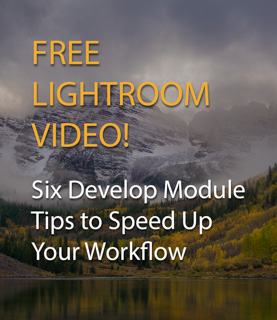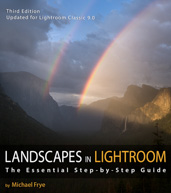In the Moment:
Michael Frye's Landscape Photography Blog
by Michael Frye | Feb 17, 2011 | Yosemite Photo Conditions
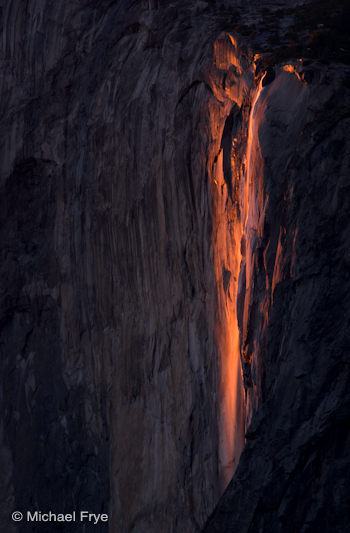 Last Friday I was in Yosemite Valley being interviewed by Steve Bumgardner for a segment of his Yosemite Nature Notes video series. After the interview I decided to head over to the Southside Drive viewpoint for Horsetail Fall. Skies were clear to the west, so the waterfall got that last orange light, but as you can see from this photo there wasn’t a lot of water. It’s a decent flow for this ephemeral fall, better than in some years, but a little below average. Compare the accompanying photo to this one from 2010, or another from 2009. Of course none of these approach the tremendous volume of water in my image from February 1995.
Last Friday I was in Yosemite Valley being interviewed by Steve Bumgardner for a segment of his Yosemite Nature Notes video series. After the interview I decided to head over to the Southside Drive viewpoint for Horsetail Fall. Skies were clear to the west, so the waterfall got that last orange light, but as you can see from this photo there wasn’t a lot of water. It’s a decent flow for this ephemeral fall, better than in some years, but a little below average. Compare the accompanying photo to this one from 2010, or another from 2009. Of course none of these approach the tremendous volume of water in my image from February 1995.
Despite the less-than-spectacular flow, clear skies last weekend allowed many people to capture some nice Horsetail Fall images. You can find links to a few of those photos in the comments of my last post about Horsetail from February 8th.
Meanwhile, a snowstorm deposited about six inches of snow on the valley floor yesterday. Another larger storm is predicted to bring snow tonight through Saturday. We may get a break Sunday or Monday, so Horsetail photos might still be possible again this year. The cold weather has diminished the flow in Horsetail even further, but one warm, sunny day could revive it.
But hey, Horsetail, schmorsetail—we’ve got snow! And clouds, and the chance for clearing storm photos when the next system departs. After six weeks of rather bland skies, it’s nice to see some interesting weather. We could have some great photo opportunities in Yosemite over the next week.
I’ve had a busy workshop schedule, plus a last-minute writing assignment, so I haven’t been able to devote time to the next photo critique, but I should be able to post that next week. I think it will be an interesting one, so stay tuned!
by Michael Frye | Feb 8, 2011 | Yosemite Photo Conditions

Horsetail Fall, February 22nd, 2010
It’s here—almost. The window of best light on Horsetail Fall will begin around February 12th and continue until approximately February 22nd this year. The big questions is how much water will be in the fall.
Horsetail Fall is fed by snow melting from a small area on top of El Capitan. While there was plenty of snow up there in December, we’ve had only one small storm since January 2nd, and much of that early-winter snowpack has disappeared. Horsetail has a decent flow right now, indicating that there’s still some snow on top of El Cap, and I think there will be enough to last through the window of best light—but it might be a close call. If the snowpack holds up, and the warm, dry weather continues, it could be a banner year for Horsetail Fall photographs, with many clear sunsets.
For more details about photographing Horsetail Fall, see this article on my web site, or previous blog posts here and here. And check out the time-lapse video of Horsetail that Steve Bumgardner just posted.
Meanwhile, Yosemite Falls is still going strong, with exceptionally high flow for February, and excellent early-morning light. That light starts to shift soon—by the end of the month it’s not nearly as good. But for the next week or so the sun will strike the upper fall early, creating golden light on the water, and the chance to see rainbows from the eastern end of Cook’s Meadow.
Just to make things more interesting, there will be a full moon the night of February 17th, right in the middle of the Horsetail window. In Yosemite Valley the best opportunities for moonrise photos occur one to three days before the actual full moon date. I recommend using The Photographer’s Ephemeris to figure out the the specifics, but it looks like the moon might be visible near Half Dome at sunset on the 15th from the eastern end of the valley (Cook’s Meadow and the Ahwahnee Meadow). The evening of the 16th you might be able to see a moonrise from Tunnel View. So if you’re in Yosemite one of those days you’ll have to choose between trying to photograph Horsetail Fall or the moonrise.
If you get any good photographs of Horsetail, a moonrise, or anything else in the park, I’d love to see them, so please feel free to post links in the comments. Good luck!
by Michael Frye | Jan 11, 2011 | Yosemite Photo Conditions
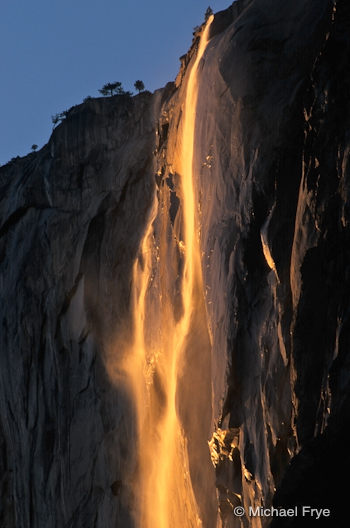
If you’re hoping to photograph Horsetail Fall this February, here’s a post from last year that outlines some of the basics about the timing and best locations. You’ll also find an article on my web site with a detailed description of the factors that go into determining the best dates to photograph this phenomenon.
Since every astronomy program seems to disagree with every other one, it’s hard to figure out exactly what the best dates are each year, but it appears that the window of best light will be a little later this February, from about the 12th to 22nd. Good luck!
by Michael Frye | Oct 25, 2010 | Vision and Creativity
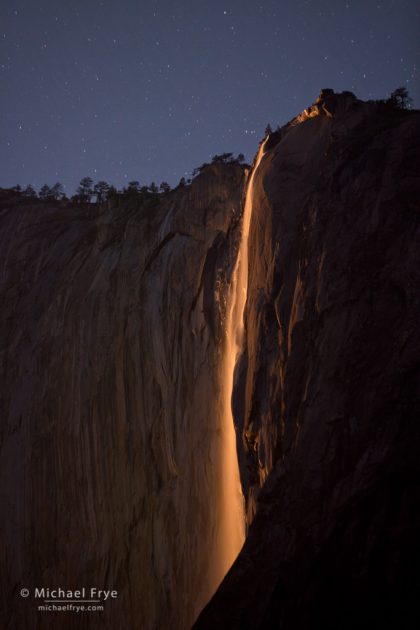
Horsetail Fall by moonlight, Yosemite NP, CA, USA
Horsetail Fall has become a celebrity, attracting more lenses than Brangelina. In February hundreds of photographers try to catch the fleeting sunset light on this little waterfall. Suitable vantage points are limited, so it’s hard to find new and different ways to portray this iconic subject. But it occurred to me that if I could catch the moon setting at just the right angle I might be able to photograph it at night.
It turns out that the right conditions for moonset light on Horsetail Fall are quite rare. The moon’s path varies greatly as it waxes and wanes. It has to set at the right angle while close to full (to provide enough light), before sunrise (so the dawn light doesn’t wash out sky), and there has to be water in the fall. Such conditions may occur only once every other year, at most.
Fortunately I found perfect conditions last spring. As I walked up to one of my favorite Horsetail Fall viewing locations at about 4 a.m., I saw an amazing sight: that beautiful, low-angle backlight on the waterfall, with the cliff behind it in the shade. It looked exactly like it does at sunset in February, only with stars in the sky above it.
Our eyes can’t see color in the dark, but cameras can, so as soon as I made my first test exposure I could see that now-classic orange glow on my LCD screen. I used both short and long shutter speeds, but ended up liking the short ones, with pinpoint stars, best.
This photograph was selected to be part of the Best of Nature show at the Ordover Gallery in the San Diego Natural History Museum. Two more of my images, Winter Sunrise From Tunnel View, and Winter Morning Along the Merced River, were also chosen. The opening reception is November 13th, 11 a.m. to 1 p.m., and will be on view until January 30, 2011. Hope to see some of you at the reception!
Speaking of Horsetail Fall, right now is it’s mirror season. The light is identical to February, and the only reason hundreds of photographers don’t try to photograph it in October is because there’s usually no water in the fall. But Yosemite Valley received almost four inches of rain in the last 48 hours, so there should be plenty of water in Horsetail Fall for the next day or two.
by Michael Frye | Feb 1, 2010 | Yosemite Photo Conditions
It’s February, so Horsetail Fall season has nearly arrived. Herds of photographers will soon be standing tripod-to-tripod hoping to catch that magical neon glow on this ephemeral slice of water.
Conditions have to be just right to capture a classic Horsetail Fall image: Sufficient water has to be flowing, and the skies need to be clear in the west to allow the setting sun to light the waterfall. It looks like the first condition will be met, as there’s plenty of snow on top of El Capitan to feed Horsetail. How clear the skies will be is anybody’s guess at this point. The ideal scenario would be a stretch of warm clear days during the peak window of light, but that seems unlikely in this El Niño winter.
About that peak window: I posted an article on my website last year describing how I used the Yosemite Association’s web cam to determine the optimum window of light for Horsetail Fall. My conclusion was that the peak day occurred about 60 days after the winter solstice, with the best light stretching from about seven days before that to three days after that. I’ve since learned that the earth wobbles a bit in its orbit, so the sun doesn’t set at exactly the same angle 60 days before the solstice as it does 60 days after the solstice. So I now use the angle — the azimuth — of the setting sun as the best way of determining when the peak day will be. This year February 18th comes closest to the ideal angle, with the window of best light stretching from about February 11th through February 21st.
There are basically two good spots to photograph Horsetail: near the El Capitan picnic area along Northside Drive, and along Southside Drive about .8 miles east of the Cathedral Beach picnic area. I prefer being near the El Capitan picnic area, but both locations have their virtues.
Many people have asked me if I’ll be doing one-day Horsetail Fall workshops again this year with The Ansel Adams Gallery, but I’ll be attending the North American Nature Photography Association’s (NANPA) Summit in Reno from February 16-19, so I’ll miss most of the Horsetail Fall craziness. The Gallery will be hosting a couple of afternoon photo classes with their staff photographers during that time, and if conditions are right they will lead their groups to good spots for Horsetail Fall.
Even though I might miss out, I hope we get some clear sunsets between February 11th and 21st, as that would make many other photographers happy! Good luck to all of you with Horsetail aspirations this year.
 Last Friday I was in Yosemite Valley being interviewed by Steve Bumgardner for a segment of his Yosemite Nature Notes video series. After the interview I decided to head over to the Southside Drive viewpoint for Horsetail Fall. Skies were clear to the west, so the waterfall got that last orange light, but as you can see from this photo there wasn’t a lot of water. It’s a decent flow for this ephemeral fall, better than in some years, but a little below average. Compare the accompanying photo to this one from 2010, or another from 2009. Of course none of these approach the tremendous volume of water in my image from February 1995.
Last Friday I was in Yosemite Valley being interviewed by Steve Bumgardner for a segment of his Yosemite Nature Notes video series. After the interview I decided to head over to the Southside Drive viewpoint for Horsetail Fall. Skies were clear to the west, so the waterfall got that last orange light, but as you can see from this photo there wasn’t a lot of water. It’s a decent flow for this ephemeral fall, better than in some years, but a little below average. Compare the accompanying photo to this one from 2010, or another from 2009. Of course none of these approach the tremendous volume of water in my image from February 1995.



